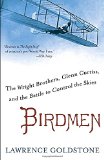Summary | Excerpt | Reviews | Beyond the Book | Readalikes | Genres & Themes | Author Bio
The Wright Brothers, Glenn Curtiss, and the Battle to Control the Skies

Critics' Opinion:
Readers' Opinion:
First Published:
May 2014, 448 pages
Paperback:
Apr 2015, 448 pages
 Book Reviewed by:
Book Reviewed by:
Poornima Apte
Buy This Book
The spate of interest in heavier-than- air flight notwithstanding, most, even in the scientific community, continued to deem the notion fanciful at best. (Balloons, which had been around since the Montgolfier brothers soared over Annonay a century earlier, were an accepted public phenomenon, although controlling the contraptions remained a problem.) In 1890, Matthias Nace Forney, an old friend who was a railroad engineer and journalist, asked Chanute to contribute some articles of interest to an engineering journal he had begun editing, American Engineer and Railroad Journal. Forney did not specifically request that the articles be about aviation, but he was keen to publish material to help entice sales.
Chanute drew on his correspondence, supplemented with additional research, and submitted to Forney a series of articles on some of the various streams of research and development and aviation, including, of course, Mouillard's. Chanute originally planned six to eight articles "but investigation disclosed that far more experimenting of instructive value had been done than was at first supposed," and the series ran to twenty-seven. Eventually these articles were compiled in book form and published in 1894 as Progress in Flying Machines. "Naturally enough the public has taken little heed of the progress really made toward the evolution of a complicated problem, hitherto generally considered as impossible of solution," Chanute wrote in his preface, and "it will probably be surprised to learn how much has been accomplished toward overcoming the various difficulties involved, and how far the elements of a possible future success have accumulated within the last five years."
Chanute was careful to restrict his inquiry to heavier-than- air machines. Unlike many of his contemporaries, Chanute understood that balloons were not corollary but represented an entirely different set of engineering principles and problems. Progress in Flying Machines was divided into three sections: "Wings and Parachutes," by which he meant ornithopters; "Screws to Lift and Propel"; and "Aeroplanes," meaning fixed-wings. In his conclusion, Chanute correctly noted, "The problem of the maintenance of the equilibrium is now, in my judgment, the most important and difficult of those remaining to be solved. . . . Almost every failure in practical experiments has resulted from lack of equilibrium."
The book closed with an appendix by Otto Lilienthal, "The Carrying Capacity of Arched Surfaces in Sailing Flight." Lilienthal was by then the accepted authority on the lift and soaring properties of cambered surfaces, for which there are five key measurements: length from the center of the craft; chord, the distance from the front to the back; surface area, derived by multiplying length by average chord; aspect ratio, which is length divided by average chord and determines shape (thus a wing 10 feet long with a 2-foot average chord would have a surface area of 20 square feet and an aspect ratio of 10:2, where a wing 5 feet long with a 4-foot average chord would have the same surface area but a stubbier aspect ratio of 5:4); and camber, which is the measure of the height of wing curvature against average chord. The tables Lilienthal had produced incorporating these measurements were unquestioned as to accuracy.
Progress in Flying Machines was read by virtually everyone who was experimenting in flight and anyone who was considering it. Its publication in many ways marked the beginning of aviation as a rigorous science and fertilized the soil from which the Wright Flyer sprung nine years later.
So popular was Chanute's work that it almost instantly spawned a rush of correspondence and conferences, and a demand for more literature. In Boston, James Means, a graduate of the Massachusetts Institute of Technology and aviation enthusiast who had made a small fortune marketing low-priced, mass-produced shoes to the average American, decided to go Chanute one better. Like Chanute, Means had retired from industry to join the quest for flight, but unlike the railroad man, he made some formative efforts at design on his own. Means saw the world more broadly than Chanute and was convinced that aviation would reach fruition only with public support and eventual government funding. In 1895, a time when many conducted their researches privately for fear of being labeled cranks, Means decided to generate enthusiasm by proclaiming in a popular medium all the wondrous achievements in aviation either at or just over the horizon. Unlike Progress in Flying Machines, whose content was often highly technical, the Aeronautical Annual would be aimed at the educated general reader.
Excerpted from Birdmen by Lawrence Goldstone. Copyright © 2014 by Lawrence Goldstone. Excerpted by permission of Ballantine Books. All rights reserved. No part of this excerpt may be reproduced or reprinted without permission in writing from the publisher.





The House on Biscayne Bay
by Chanel Cleeton
As death stalks a gothic mansion in Miami, the lives of two women intertwine as the past and present collide.

The Flower Sisters
by Michelle Collins Anderson
From the new Fannie Flagg of the Ozarks, a richly-woven story of family, forgiveness, and reinvention.

The Funeral Cryer by Wenyan Lu
Debut novelist Wenyan Lu brings us this witty yet profound story about one woman's midlife reawakening in contemporary rural China.
Your guide toexceptional books
BookBrowse seeks out and recommends the best in contemporary fiction and nonfiction—books that not only engage and entertain but also deepen our understanding of ourselves and the world around us.